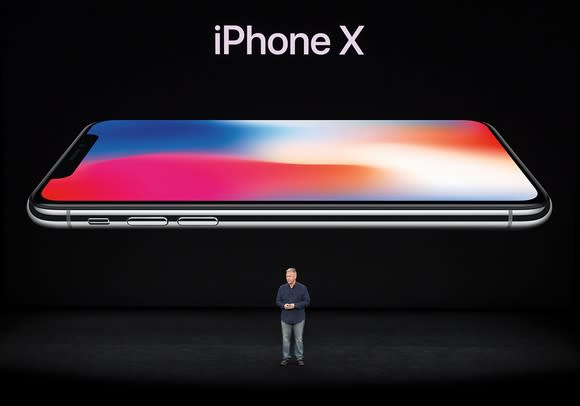Is This Chip Update in the iPhone's Future?
Apple (NASDAQ: AAPL) is expected to launch two premium iPhones with high-resolution organic light emitting diode (OLED) displays next year. One is expected to have a 5.85-inch OLED display like the one found on this year's iPhone X, though perhaps with quality and speed upgrades, and the other is expected to have a jumbo 6.46-inch OLED display.
According to KGI Securities analyst Ming-Chi Kuo, that 6.46-inch OLED display will have a pixel density -- that is, the average number of pixels per square inch -- of between 480 and 500 pixels per inch. That's greater than the 458 pixels per inch of the display found on the 5.85-inch display on the current iPhone X.

Image source: Apple.
This higher display size, coupled with the higher pixel density, will mean the display on the larger iPhone X will feature a lot of pixels. My math pegs the total pixel count at between 3.7 million and 4 million pixels. To put that into perspective, the iPhone X's display has about 2.74 million pixels and the iPhone 8 Plus' display has about 2.07 million. The standard iPhone 8's display features just 1 million.
This dramatic increase in the number of pixels on the display of Apple's highest-end iPhone next year will necessitate a big improvement in the graphics capabilities of the Apple A12 processor, since the more pixels a device's display has, the more powerful the chip driving the device needs to be.Â
Some perspective
For a 6.46-inch iPhone X to deliver the same level of graphics performance as today's iPhone X, it will need a graphics processor that's roughly 45% faster than the one found inside the A11 Bionic. For better performance, the A12 processor needs to feature a graphics processor that's greater than 45% faster than the one found in the iPhone X.
A 45% generational boost in graphics performance isn't unheard of; Apple delivered such boosts with the A8, A9, and A10 chips. It only missed the mark with this year's A11 Bionic chip, which improved graphics performance by only 30% over its predecessor.
Indeed, given that Apple is likely to introduce a new iteration of its custom-designed graphics processor technology in the A12, and given that Apple will also build the A12 on a more advanced chip-manufacturing technology, hitting that mark seems more than doable.
How Apple can avoid treading water
One thing worth pointing out is that if Apple uses the same A12 chip inside both next-generation OLED iPhones, the one with the lower-resolution 5.85-inch display would see a clear speed boost over this year's iPhone X. A large boost in the graphics performance of the A12 would only allow next year's 6.46-inch iPhone X to deliver a similar experience to this year's iPhone X and a slower experience than what an updated 5.85-inch iPhone X would deliver.
To be clear, this disparity in effective graphics performance between Apple's smaller-screen and larger-screen iPhones isn't new and has existed since Apple introduced the iPhone 6 and iPhone 6 Plus back in 2014.

Image source: Apple.
Nevertheless, given that Apple has continued to invest heavily in building out its chip capabilities and currently spends nearly $12 billion per year in research and development, a figure that's only been growing, I continue to believe that Apple easily has the technical and financial resources to build customized versions of its A-series chips tailored to the display demands of the smaller- and larger-screen iPhone models.
Ideally, Apple's next 5.85-inch iPhone would include the A12 chip while the 6.46-inch iPhone could have a chip called the A12 Plus, which would have a graphics processor with, say, 50% more graphics cores embedded inside it.
The Plus versions of Apple's A-series chips would be more expensive to build and consume more power than their non-Plus counterparts, but considering they would be going into more expensive phones with much larger batteries than their non-Plus counterparts, that really shouldn't be a problem.
There hasn't been much noise from the usual suspects in the Apple supply chain about Apple's potentially doing separate versions of the A-series chips for each iPhone based on display size. But I wouldn't be surprised to see Apple adopt such a strategy within the next product cycle or two for the sake of the user experience.
More From The Motley Fool
6 Years Later, 6 Charts That Show How Far Apple, Inc. Has Come Since Steve Jobs' Passing
Why You're Smart to Buy Shopify Inc. (US) -- Despite Citron's Report
Ashraf Eassa has no position in any of the stocks mentioned. The Motley Fool owns shares of and recommends Apple. The Motley Fool has the following options: long January 2020 $150 calls on Apple and short January 2020 $155 calls on Apple. The Motley Fool has a disclosure policy.

 Yahoo Finance
Yahoo Finance 